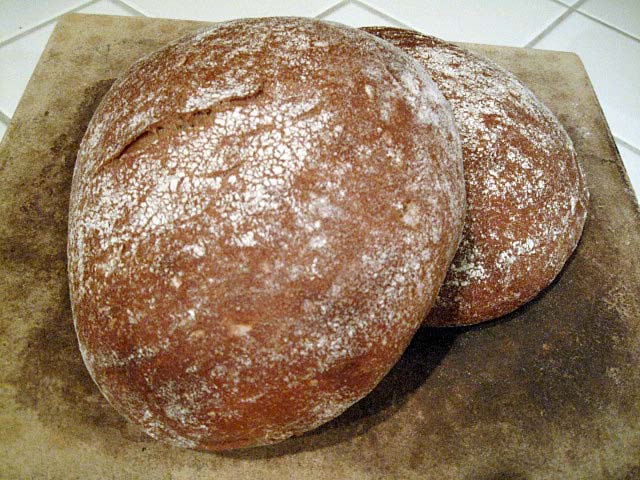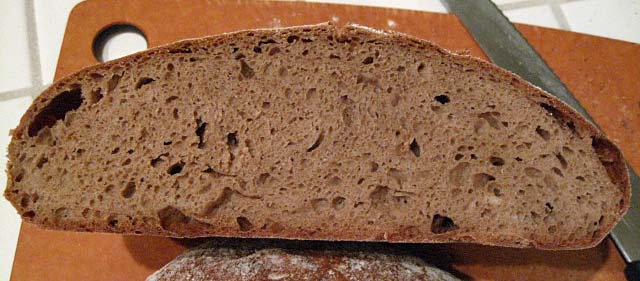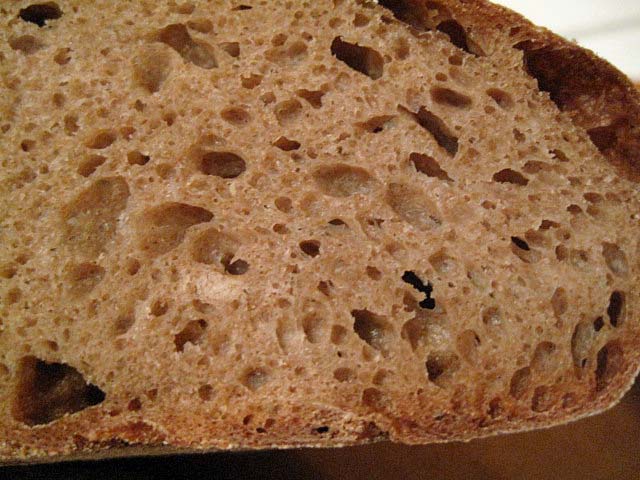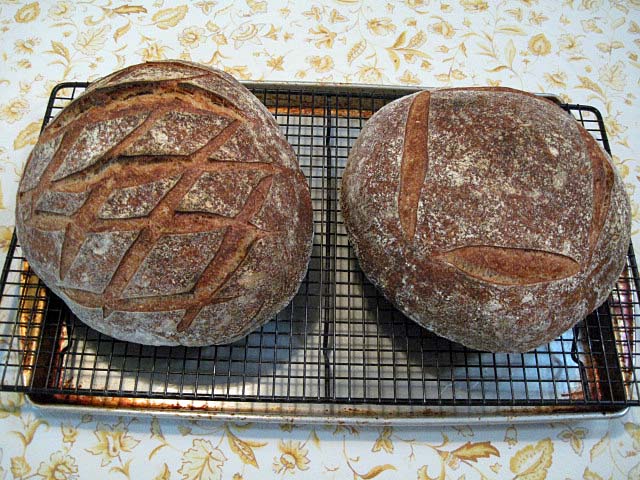
Phil's Desem & SFBI Miches 5/18/12

This was my second bake of Phil's (PiPs) Desem. His beautiful blog entry on this bread can be viewed here: Honest bread - 100% whole-wheat desem bread and some country bread. As with my first bake, I modified Phil's procedure somewhat, using CM fine ground organic whole wheat flour rather than fresh-ground white WW flour and machine mixing. While I baked directly on a stone last time, today I baked in Lodge 4 qt. Cast Iron Dutch ovens.

Desem crust close-up
The general appearence of the loaves was pretty much the same between the two baking methods. I understand that Phil is contending with the special challenges of a gas oven, but, for me, baking on the stone directly is easier than wrangling hot and heavy DO's.

Desem crumb profile

Desem crumb close-up
I cut the desem loaves 3-4 hours after baking. The crumb structure was very satisfactory, but it was somewhat gummy. Hansjoakim (see below) raised an excellent question: Would the desem benefit from a 24-36 hour rest before slicing, like a high-percentage rye does? I wonder.
The flavor of the desem, tasted when first sliced was very assertive - sweet whole wheat with a moderate sour tang. The sourness had decreased the next morning when I had it toasted for breakfast. It was very nice with butter and apricot jam.
I also baked a couple 1 kg loaves using the SFBI Miche formula. (See Miche from SFBI Artisan II - 2 kg) I altered the flour mix. The final dough was made using half KAF AP and half CM Organic Type-85 flour.



We had some of this bread with dinner. The crust was crunchy and the crumb was soft but chewy. The flavor was complex - sweet, wheaty and mildly sour. I have made this bread using the original SFBI formula, with all CM Type-85 flour and with the mix I used today. I'd be hard pressed to say which I prefer. They have all been delicious.
I'm happy with today's bakes.
David


Comments
Hi David,
I think you should have every reason to be happy with the breads. They look wonderful - I really enjoy the colour and specks of flour on the crust of both breads. I look forward to reading more about the desem! Do you think a desem bread particularly benefits from some rest time between baking and slicing? I guess it could be similar to rye in that respect, as the flavours need some time to mingle and can sometimes not be completely developed before 24 - 36 hours? There are probably no issues with gummy/sticky crumb in a desem crumb, however, as there are in rye the first day after baking?
Again, wonderful breads, David!
Your question regarding delayed slicing of the desem is a good one. I sliced the bread late last night, about 3-4 hours after it came out of the oven. The crumb structure was very nice. I'll post photos later this morning. However, it was somewhat gummy. I think it would have benefitted from an overnight rest, like a rye does. It was not under-baked; the temperature was over 205 dF when I took it out of the oven. The flavor was very good.
I hope Phil comments on this.
David
are very consistent David, high quality, and seem to be reproducible even between long layoffs doing other linds of bread. These breads look especially nice. Can't wait to see the Desem crumb.
David
very moist and just perfect for toasting. My YW breads and those with much whole grains and high hydration sometimes come out that way if I don't bake them to 208 - 210 F. I don't mind since most bread tastes better toasted in my book anyway. Some breads just need more than 205 F interior I'm thinking. I'm surprised the SD tang was less the next day. How often does that happen? If it tastes worse toasted then you are on to another discovery :-)
Very nice crumb f0r this bread.
I find that changes in sourness with "aging" vary, but tend to decrease in predominantly whole grain breads - wheat or rye. I don't understand the chemistry, unless the acetic acid is just evaporating.
I assure you it did not taste worse toasted. :-)
David
David
you get the bear :>)
David
the appearance of the crust of the desem. It seems quite unique to this bread. All your loaves look terrific. -Varda
As always your breads look fantastic.
I will tell you that my Desem bake from last week did not turn out gummy as you put it. Not sure why yours did, and would be curious to know if you figure it out. Either way your crust and crumb look pretty good to me.
I'm working on a multi flour version with toasted onions, quinoa flour, barley flour and toated wheat germ. We will see how it comes out tomorrow night...
shot. The loaves look delicious. I sure wish we had some bread in the house : ) For now I will have to enjoy the lovely photos of your bakes with all my senses! Very nicely done, David!
Sylvia
Hi David,
Desem is looking great again! Looks a nice crumb ... a darker shade than the white wheat I am using. The miche are beautiful!
I have had gummy crumbs on rare occasions - and I ususally find they slice best the following day ... though the nicest one we ever had was still warm from the oven with some butter ... would have made a terrible 'crumb shot' for the blog though :)
With regards to the gummy crumb I wonder if it has to do with being baked in the cast iron pot? I usually take the entire loaf out of the pot after the first 15-20 minutes and bake it for the remaining time on a stone ... this ensures the crust colour is even. Perhaps this helps drive off some of the moisture?
Also what hydration are you using?
cheers,
Phil
The gummy crumb may have been due to covered baking, but mine was baked in the very shallow lid, with the deeper part of the pot as a cover. It was nicely and evenly browned. I did leave it on a baking stone in the oven for a few minutes after it was done, according to the internal temperature.
Probably the covered baking did result in more moisture being retained.
The dough hydration was exactly as in your "Honest Bread ..." blog and the same as my first desem bake, which had lovely crumb texture.
David
Hello David,
Beautiful breads; both types.
That is a great suggestion from Hans to delay slicing the bread. The crumb is very close to the Gilchesters' Miche which I make using locally grown wheat, ground at approximately 85% extraction.
I'm not sure I can fully explain the gummy crumb in your case. as you have clearly baked out the loaf properly. I am not familiar enough with the Type 85 flour you use, but from what you have said, it works up a good strength of dough. The danger for Phil when using freshly milled flour is that it won't have been able to age sufficiently and oxidise. so the resulting dough will lack strength. Hamelman is good to read more about this.
Best wishes to you
Andy
See my response to Phil, above. My hunch is that the gummy crumb could be averted several ways: 1) baking on a stone with my usual oven steaming method, 2) Letting the loaf rest for 24-36 hours to stablilize the moisture distribution, or 3) Letting the loaves sit in the oven, on the stone, with the heat off and door ajar for 30 minutes.
Just to clarify, the desem was 100% WW flour. The CM Type 85 was used in the miches. It is a lovely flour to work with and has a delicious flavor in sourdough breads.
David
All your breads look great David! And I know I have said this many times, but I really love that miche.
Best,
Syd
We love the miche, too. I think my wife ate more of it than I did this time, an heretofore unheard of occurance!
David
Just having a "senior moment" David, sorry about that
Andy
Hi David,
I love the color of the desem bread crumb, and the dark crust on your SFBI miche looks fantastic - both breads look absolutely delicious.
Thanks for the reminder of that SFBI miche formula - it's a good one!
:^) breadsong
The gummy texture and "sweet whole wheat with a moderate sour tang" make me think you perhaps over-fermented?
Desem shouldn't taste sour at all. Maybe a touch toward the end of the week... .
I don't think the dough was over-fermented, but it's been a while since I made it.
You sound experienced with desem. I've never made one that I thought was completely wonderful, and I've never had one in its native land. If you have a favorite formula and method for desem, please share it.
David